- Kenmore refrigerator water filters
- Whirlpool refrigerator water filters
- Samsung refrigerator water filters
- GE refrigerator water filters
- LG refrigerator water filters
- Frigidaire refrigerator water filters
- KitchenAid refrigerator water filters
- Maytag refrigerator water filters
- Kenmore Elite refrigerator water filters
- Estate refrigerator water filters
- GE Profile refrigerator water filters
- Amana refrigerator water filters
- Bosch refrigerator water filters
- Dacor refrigerator water filters
- Electrolux refrigerator water filters
Can’t find your part? Contact us: +1-309-603-4777
Top DIY repair help
View All Repair Categories
Appliances
Lawn & Garden
Power Tools
Home Improvement
Sports & Leisure
Heating & Cooling
OrdersSchedule a repair
Keep track of the models you own in your profile
Sign in or Register to view or add models
How to replace the lid switch in a direct-drive top-load washer
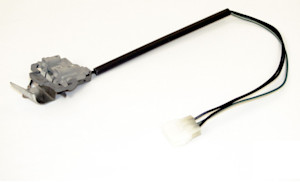
This DIY washer repair guide explains how to replace the lid switch in a top-load washer. The lid switch is a safety device that prevents the washer from going into spin mode when the lid is open. If the lid switch doesn't work, the washer won't spin even when closed. Replace the lid switch with a manufacturer-approved washer part.
Use this repair procedure to replace the lid switch in Kenmore, Whirlpool, Maytag, Roper, Estate and Crosley top-load washers.
We also have instructions for replacing the lid switch/lock on a VMW top-load washer. If you're not sure if your top-load washer has VMW technology, check out our washer FAQsto see how you can tell.
Quick links
Video
Instructions
Tools required
Phillips screwdriver
Slot screwdriver
Work gloves
Repair difficulty
Time required
15 minutes or less
Repair difficulty
Time required
15 minutes or less
Replacing a lid switch on a direct-drive top-load washer
This video explains how to replace the lid switch on a direct-drive top-load washer.
Instructions
- 01.
Shut off the electricity
Unplug the power cord from the wall outlet.
Wear work gloves to protect your hands.
- 02.
Open the control console
Pull the plastic end caps off the sides of the control console.
Remove the screws at the base of the control console.
Pull the control console slightly forward and then swing it up and over the top of the back panel.
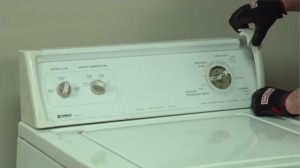
PHOTO: Remove the control panel endcaps.
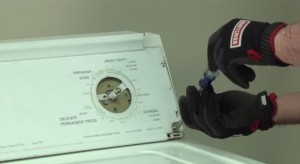
PHOTO: Remove the screws at the base of the control panel.
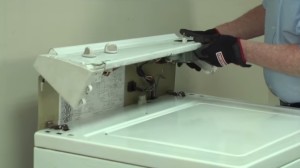
PHOTO: Open the control panel by pulling it slightly forward and then swinging it up and back.
- 03.
Remove the cabinet
Unplug the wire harness from the lid switch on the washer’s top panel.
Release the clips that secure the cabinet to the washer’s back panel. Using a slot screwdriver, pry the clips forward to release them from the slots in the top panel.
Lift the back of the cabinet and slide the cabinet forward to remove it from the washer frame.
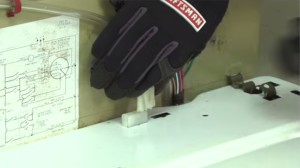
PHOTO: Unplug the wire harness from the lid switch.
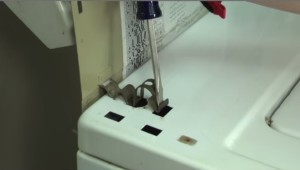
PHOTO: Release the clips that hold the cabinet to the back panel.
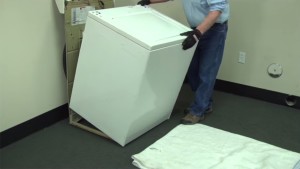
PHOTO: Slide the cabinet forward and remove it from the frame.
- 04.
Remove the lid switch
Press in on the lid switch wire harness plug locking tabs to release them and then pull the plug out of the top cabinet panel.
Release the green ground wire by removing the screw that secures it to the cabinet.
Remove the lid switch mounting screws.
Release the lid switch wire harness from the clips and pull the lid switch out of the cabinet.
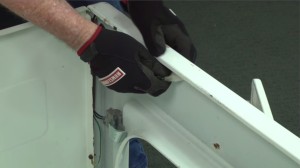
PHOTO: Pull out the lid switch wire harness plug.
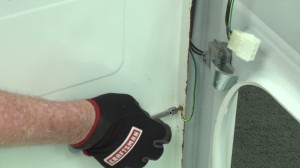
PHOTO: Remove the green ground wire from the washer cabinet.
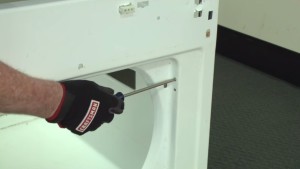
PHOTO: Remove the lid switch mounting screws.
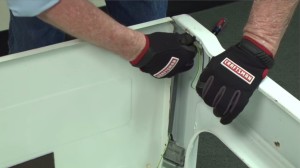
PHOTO: Remove the lid switch from the cabinet.
- 05.
Install the new lid switch
Position the new lid switch in the cabinet and reinstall the mounting screws.
Insert the lid switch wire harness into the harness clips and snap the wire harness plug into the cabinet top panel.
Reconnect the green ground wire using the mounting screw.
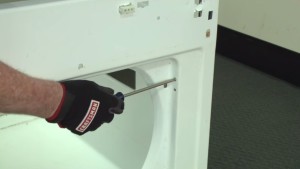
PHOTO: Install the lid switch mounting screws.
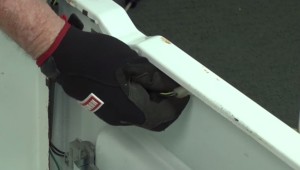
PHOTO: Install the lid switch wire harness plug.
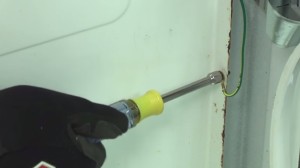
PHOTO: Connect the green ground wire to the cabinet.
- 06.
Reinstall the cabinet
Position the cabinet in front of the washer.
Tilt the back of the cabinet up slightly and keep the front lip of the cabinet on the floor. To position the front lip under the washer frame, push the base of the cabinet forward with your foot to slide the front lip of the cabinet under the front base of the washer. Then lower the back of the cabinet so the alignment tabs at the back sides of washer base fit into the holes on the back sides of the cabinet.
Reinstall the spring clips at the top of the cabinet.
Plug the lid switch wire harness back into the receptacle on the top panel of the washer.
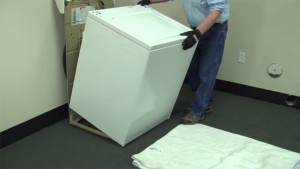
PHOTO: Reinstall the washer cabinet.
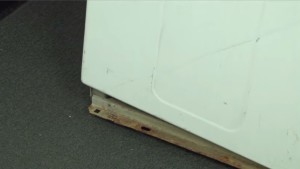
PHOTO: Engage the rear cabinet tabs.
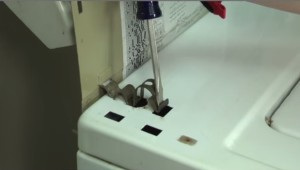
PHOTO: Reinstall the spring clips at the top of the cabinet.
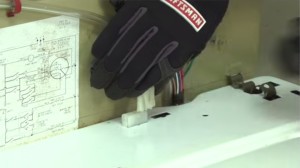
PHOTO: Plug in the lid switch wire harness back into the receptacle.
- 07.
Reinstall the control console
Flip the control console down and position it properly on the top panel of the washer.
Reinstall the mounting screws at the base of the control console.
Snap the plastic end caps onto the sides of the control console.
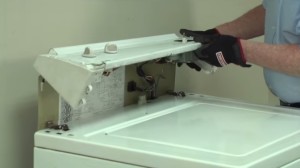
PHOTO: Flip the control panel down and close the console.
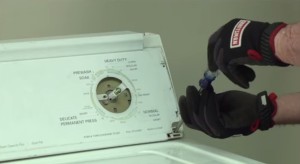
PHOTO: Reinstall the control console mounting screws.
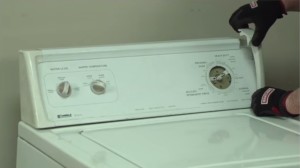
PHOTO: Reinstall the control panel endcaps.
- 08.
Restore the power
Plug the washer into the electrical outlet.
Warning: Undertaking repairs or maintenance to appliances or power equipment can be hazardous. Should you choose to undertake repairs or maintenance, you are assuming the risk of injury to your person or property. In an effort to reduce the risk, use the proper tools and safety equipment noted in the applicable guide and follow all instructions. Do not proceed until you are confident that you understand all of the steps and are capable of completing the repair. Some repairs or maintenance, however, should only be performed by a qualified technician.
Was this information helpful?
Most common symptoms to help you fix your washers
Choose a symptom to see related washer repairs.
Main causes: clogged drain hose, house drain clogged, bad drain pump, water-level pressure switch failure, bad control b…
Main causes: worn agitator dogs, bad clutch, broken motor coupler, shifter assembly failure, broken door lock, suspensio…
Main causes: bad lid switch or door lock, bad timer or electronic control board, wiring failure, bad water inlet valve a…
Main causes: broken lid switch or lid lock, bad pressure switch, broken shifter assembly, faulty control system…
Main causes: unbalanced load, loose spanner nut, worn drive block, broken shock absorber or suspension spring, debris in…
Main causes: no water supply, bad water valves, water-level pressure switch failure, control system failure, bad door lo…
Main causes: lack of electrical power, wiring failure, bad power cord, electronic control board failure, bad user interf…
Main causes: leaky water inlet valve, faulty water-level pressure switch, bad electronic control board…
Main causes: water heater failure, bad water temperature switch, faulty control board, bad water valve, faulty water tem…
Repair guides for top-load washers

How to replace the motor coupler on a top-load washer
If the washer drains but won’t agitate or spin, the motor coupler might have broken to protect the drive motor from dama…
Repair difficulty
Time required
60 minutes or less

How to replace the agitator dogs in a top-load washer
If the top of the agitator moves both ways instead of just one, replace the agitator dogs, using the steps in this repai…
Repair difficulty
Time required
15 minutes or less

How to replace the drive block on a top-load washer
The drive block rotates the spin basket. If the basket wobbles or rattles in the spin mode because the drive block is wo…
Repair difficulty
Time required
60 minutes or less
Effective articles & videos to help repair your washers
Use the advice and tips in these articles and videos to get the most out of your washer.

Agitator or impeller? One scrubs, one swirls. Find out which washer type fits your laundry needs—and why it might explai…

We've put together some tips on keeping your washing working well.…

Learn about all the convenient features on our Sears PartsDirect website that make your parts purchases easier.…
Parts & More
Parts
Refrigerator Door Hinge Cover ACQ77080312 partsRange Control Panel 316448427 partsMetric Machine Screw, 8-pack STD863416 partsLawn Mower Axle Assembly, Right 938-04004A partsRefrigerator Grommet 67003493 partsRefrigerator Leveling Leg WPW10340017 partsRefrigerator Freezer Drawer Slide Rail Cover DA63-05451A partsRefrigerator Suction Line DA97-12410A partsRange Hood Installation Kit 5304485280 partsDishwasher Electronic Control Board WD21X10404 partsDryer Door (White) W10111878 partsDowndraft Vent 36-inch Model Grease Filter W10425128 partsLawn Tractor Snow Blade Attachment Angle Lock Bar, Short 23151 partsPush Button 8181678 partsLawn Tractor 42-in Deck Sand Blade 942-04312-L partsRefrigerator Dispenser User Interface Control W11130211 partsRefrigerator Ice Bank Door Gasket W10347085 partsRange LP Conversion Kit W10854965 partsRange Oven Door Outer Panel (Black) WB56K31 partsSnowblower Flange Bearing 577023MA parts